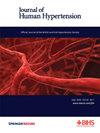The association between objectively measured physical activity and home blood pressure: a population-based real-world data analysis
IF 3.4
4区 医学
Q2 PERIPHERAL VASCULAR DISEASE
引用次数: 0
Abstract
Few studies have examined the association of objectively measured habitual physical activity (PA) and sedentary behavior with out-of-office blood pressure (BP). We investigated the associations of objectively measured PA intensity time, sedentary time, and step count with at-home BP. Using accelerometer-recorded PA indices and self-measured BP in 368 participants (mean age, 53.8 years; 58.7% women), we analyzed 115,575 records of each parameter between May 2019 and April 2024. PA intensities were categorized as light (2.0–2.9 metabolic equivalents [METs]); moderate (3.0–5.9 METs); vigorous (≥6.0 METs), or sedentary (<2.0 METs): the median [interquartile ranges] for these variables was 188 [146–232], 83 [59–114], 1 [0–2], 501 [428–579] minutes, respectively, and for step count, was 6040 [4164–8457]. Means [standard deviations] for systolic and diastolic BP were 116.4 [14.2] and 75.2 [9.3] mmHg, respectively. A mixed-effect model adjusted for possible confounders showed that 1-h longer in vigorous PA was associated with lower systolic and diastolic BP (−1.69 and −1.09 mmHg, respectively). A 1000-step increase in step count was associated with lower systolic and diastolic BP (−0.05 and −0.02 mmHg, respectively). Associations were more pronounced among men and participants aged <60 years. Sedentary time was positively associated with BP in men and participants aged <60 years, but inversely associated with BP in women and participants aged ≥60 years. Our findings suggest that more PA and less sedentary behavior were associated with BP reduction, particularly among men and participants aged <60 years. However, the clinical relevance of this effect remains uncertain because of its modest magnitude.

客观测量的身体活动和家庭血压之间的关系:基于人群的现实世界数据分析。
很少有研究调查客观测量的习惯性身体活动(PA)和久坐行为与办公室外血压(BP)的关系。我们调查了客观测量的PA强度时间、久坐时间和步数与家庭血压的关系。采用加速度计记录的PA指数和自测BP 368例(平均年龄53.8岁;58.7%女性),我们分析了2019年5月至2024年4月期间每个参数的115575条记录。PA强度分为轻度(2.0-2.9代谢当量[METs]);中度(3.0-5.9 METs);剧烈运动(≥6.0 METs)或久坐(
本文章由计算机程序翻译,如有差异,请以英文原文为准。
求助全文
约1分钟内获得全文
求助全文
来源期刊

Journal of Human Hypertension
医学-外周血管病
CiteScore
5.20
自引率
3.70%
发文量
126
审稿时长
6-12 weeks
期刊介绍:
Journal of Human Hypertension is published monthly and is of interest to health care professionals who deal with hypertension (specialists, internists, primary care physicians) and public health workers. We believe that our patients benefit from robust scientific data that are based on well conducted clinical trials. We also believe that basic sciences are the foundations on which we build our knowledge of clinical conditions and their management. Towards this end, although we are primarily a clinical based journal, we also welcome suitable basic sciences studies that promote our understanding of human hypertension.
The journal aims to perform the dual role of increasing knowledge in the field of high blood pressure as well as improving the standard of care of patients. The editors will consider for publication all suitable papers dealing directly or indirectly with clinical aspects of hypertension, including but not limited to epidemiology, pathophysiology, therapeutics and basic sciences involving human subjects or tissues. We also consider papers from all specialties such as ophthalmology, cardiology, nephrology, obstetrics and stroke medicine that deal with the various aspects of hypertension and its complications.
 求助内容:
求助内容: 应助结果提醒方式:
应助结果提醒方式:


